What is Child’s Pose (Balasana)?
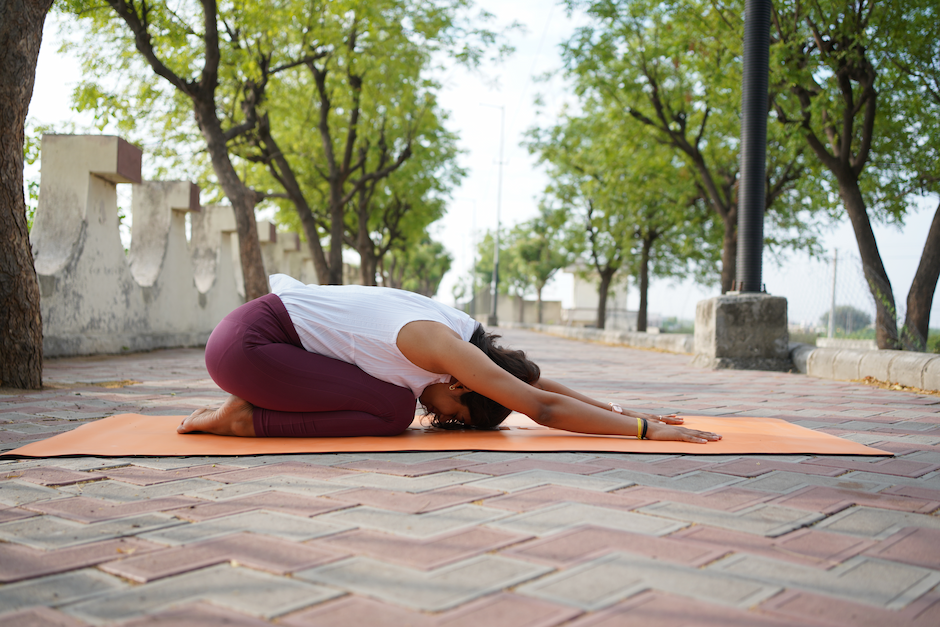
Child’s Pose (Balasana) is a gentle kneeling yoga pose that stretches the spine, hips, thighs, and ankles while calming the mind and relieving stress. It’s one of the most beginner-friendly and restorative yoga poses, often used between sequences or after challenging postures to rest and reconnect with the breath.
Child’s Pose: Overview and Meaning of Balasana
In Sanskrit, bala means “child,” and asana means “pose.” True to its name, this posture mirrors a child’s natural resting position, symbolizing safety, surrender, and trust. It encourages the same qualities in adults, offering a moment to soften, ground, and reconnect. More than rest, it’s an active choice to pause with awareness — a reminder that stillness is a form of strength, not inactivity.
While Child’s Pose doesn’t appear in early texts like the Hatha Yoga Pradipika or Gheranda Samhita, it likely emerged in the 20th century, as modern yoga began to emphasize mindful movement, recovery, and the breath–body connection. Over time, teachers adopted Balasana as a safe, neutral position to pause, observe the breath, and reset the spine. By the mid-1900s, it had become a cornerstone in Hatha and Vinyasa classes — the universal gesture of “rest anytime you need to.”
In modern yoga practice, Child's Pose has become the universal rest position across all styles—from vigorous Vinyasa flows to gentle Restorative classes. Physically, it eases the lower back and hips while encouraging mindful breathing. Mentally, it calms the nervous system and promotes emotional release — especially when supported with props for longer holds.
For many, Balasana becomes more than a resting shape; it’s a reset for the body and mind, teaching the strength of softness and the power of pause.
At A Glance:
- Sanskrit Name: बालासन (Balasana)
- Pronunciation: bah-LAHS-anna
- English Name: Child’s Pose, Resting Pose
- Pose Type: Resting / Forward Bend / Restorative
- Level: Beginner
- Duration: 30 seconds to 5+ minutes
Benefits of Child’s Pose (Balasana)
Child’s Pose (Balasana) offers a full-body stretch that relieves back and hip tension, improves flexibility, and calms the mind. Its gentle forward fold promotes relaxation, supports digestion, and helps restore vitality after physical or mental stress.
Physical Benefits of Child’s Pose
- Back pain relief: As you fold forward, your spine elongates naturally, easing lower back pain and stiffness caused by prolonged sitting.
- Hip and thigh opening: The flexion targets the hip joints, inner thighs, and quadriceps, restoring mobility in areas often tight due to inactivity.
- Neck and shoulder release: When arms are extended, gentle traction opens the shoulders and upper back.
- Circulation boost: The mild inversion improves blood flow to the brain, fostering alertness and rejuvenation.
- Digestive support: Light abdominal compression massages internal organs, stimulating natural digestion and reducing bloating.
- Menstrual comfort: Mild pressure on the lower abdomen can ease cramps and promote relaxation during menstruation.
Mental & Emotional Benefits
- Activates the parasympathetic system: This “rest and digest” state lowers stress hormones and heart rate.
- Releases mental fatigue: A short pause in Balasana can feel like a mental reset during hectic days.
- Promotes introspection: Folding forward naturally turns attention inward, nurturing self-awareness and emotional balance.
- Supports emotional release: Gentle surrender in this posture helps soften held tension and anxiety.
- Improves sleep quality: Practiced before bed, Child’s Pose calms the nervous system and prepares you for restorative sleep.
Therapeutic & Holistic Applications
- Stress reduction: Daily practice may reduce cortisol levels, improving overall resilience against anxiety.
- Headache and migraine relief: The pressure of the forehead on the mat encourages relaxation through acupressure-like stimulation.
- Support for anxiety and fatigue: With mindful breathwork, Balasana restores mental clarity and counters exhaustion.
- Prenatal modification: Wide-knee Child’s Pose with bolsters provides comfort and emotional stability during pregnancy.
How to Do Child’s Pose (Balasana): Step‑by‑Step Guide
Part 1: Preparing for Child’s Pose
Before easing into Child’s Pose, warm up your spine, hips, and shoulders with these gentle movements.
1. Cat-Cow Pose (Marjaryasana–Bitilasana)

Warms up the spine, releases stiffness, and connects movement with breath — preparing the back for the gentle rounding in Child’s Pose.
- Begin on your hands and knees in a tabletop position.
- As you inhale, drop your belly, lift your chest, and gaze forward (Cow Pose).
- As you exhale, round your spine toward the ceiling, tuck your chin to your chest (Cat Pose).
- Continue to move with your breath for 5–8 rounds.
2. Thread the Needle (Parsva Balasana)
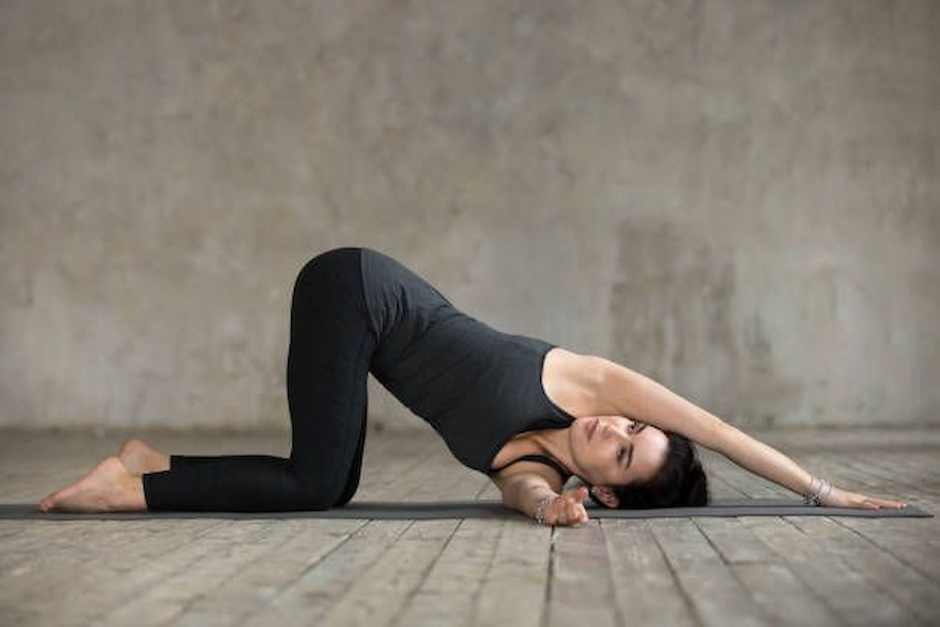
Opens the shoulders and upper back, helping the body release tension before folding inward.
- Start in tabletop position.
- On an exhale, slide your right arm under your left arm, palm facing up, resting your right shoulder and temple on the mat.
- Keep your hips lifted and your left hand pressing gently into the mat or extended forward.
- Hold for 5–8 breaths, then switch sides.
3. Seated Forward Fold (Paschimottanasana)
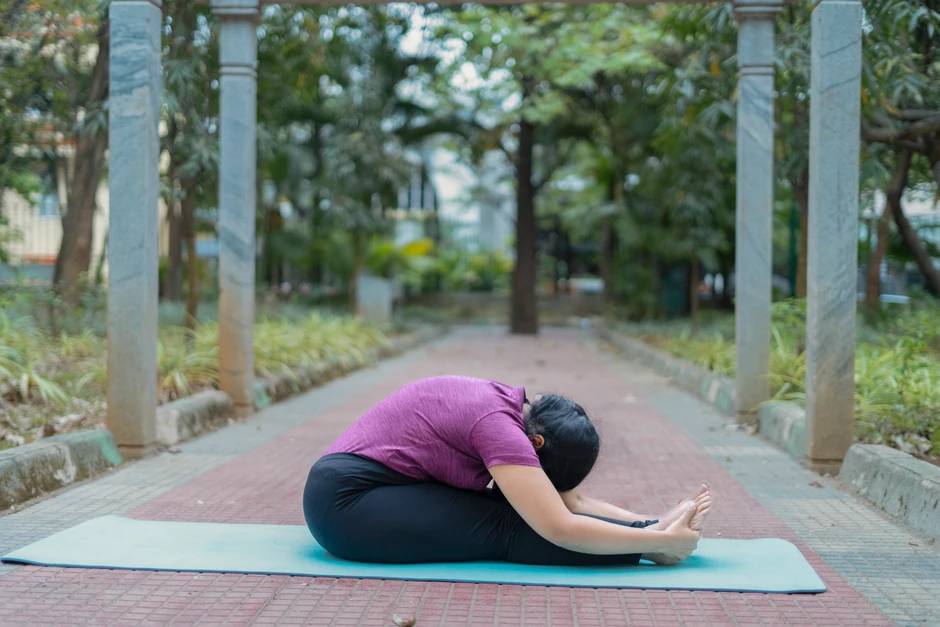
Stretches the back and hamstrings, and prepares the body to stay still and comfortable in Balasana.
- Sit with your legs extended straight in front of you.
- Inhale and reach your arms overhead, lengthening through your spine.
- Exhale and hinge forward from your hips, reaching for your feet or shins without straining.
- Stay for 5–8 breaths, keeping your spine long and your breath steady.
Part 2: How to do Child’s Pose: Step‑by‑Step Instructions
- Place your knees hip‑width apart and align your wrists under your shoulders. Point your toes straight back so the tops of your feet rest comfortably on the mat.
- Allow a gentle connection between your big toes while keeping your knees apart. This creates space for your abdomen and chest as you fold forward.
- Slowly exhale and move your hips toward your heels. Go only as far as feels comfortable — listen to your knees and thighs.
- Let your chest lower naturally between or over your thighs and bring your forehead to rest on the mat or a cushion.
- Position your arms:
- Extended version: Stretch your arms forward, palms down, to lengthen the spine.
- Restorative version: Place your arms alongside your body, palms facing up, for deeper relaxation.
- Allow your chest to release toward the mat and your shoulders to relax away from your ears.
- Inhale to expand your back and sides; exhale to release tension. Stay for 30 seconds to several minutes, depending on comfort.
- Walk your hands back toward your knees and slowly lift your torso upright, keeping your spine long.
Tip: If your hips don’t reach your heels, place a folded blanket or bolster between them for support.
Part 3: Alignment & Comfort Tips
- Keep your knees wider if your belly or chest feels compressed.
- Use a pillow or block under your forehead or chest if you can’t comfortably reach the floor.
- If you have tight ankles, roll a towel beneath them.
- Avoid straining your shoulders when your arms are extended — loosen your elbows slightly.
- Always move with your breath; never force a deeper stretch.
Learn Child’s Pose step-by-step with a coach. Book a free 1-on-1 session today!
Child's Pose Variations
Child’s Pose can be adapted for comfort, flexibility, or therapeutic needs.
Common Beginner Variations
1. Wide-Knee Child’s Pose (Utthita Balasana)
Opens the hips and relieves lower-back tension.
- Kneel on your mat and spread your knees wide while keeping the big toes touching.
- Sit back toward your heels and fold forward, bringing your torso down between your thighs.
- Rest your forehead on the mat or a block.
2. Arms-Extended Variation
Lengthens the spine and gently engages the shoulders and back.
- From Wide-Knee Child’s Pose, stretch your arms forward on the mat.
- Press your palms down lightly and reach through the fingertips.
- Allow your chest to soften toward the floor while keeping the spine long.
3. Restorative / Relaxed Child’s Pose
Minimizes shoulder engagement and encourages deeper relaxation.
- Fold forward from your knees as in Child’s Pose.
- Place your arms alongside your body, palms facing up.
- Let your shoulders and back relax fully toward the mat.
4. Supported Child’s Pose
Provides comfort and allows longer restorative holds, especially for beginners or knee sensitivity.
- Position a bolster or folded blanket beneath your torso or between your hips and heels.
- Fold forward over the support, resting your forehead on it or the mat.
- Relax your arms by your sides or drape them over the support for added ease.
Therapeutic Adaptations
These versions are often taught during therapeutic yoga sessions to address tension, fatigue, or physical limitations.
- For Tight Knees: Place a rolled towel behind your knees to lessen compression.
- For Tight Ankles: Rest your shins on a folded blanket or small cushion for comfort.
- For Lower‑Back Pain: Keep knees wide apart and rest your torso on a bolster for gentle spinal elongation.
- For Stress and Anxiety Relief: Use props to fully support your body, close your eyes, and take slow breaths. This helps stimulate the parasympathetic system, calming your mind and body.
Prenatal and Gentle Adaptations
During pregnancy or whenever comfort is a priority, Child’s Pose can be a safe and nurturing posture with mindful adjustments:
- Prenatal Child’s Pose: Widen the knees to allow space for the belly; support your chest and head with bolsters or firm pillows.
- Use Additional Props: Rest your arms or forehead on a yoga block to keep a mild elevation and protect the abdomen.
- Side‑Body Stretch Variation: Walk your hands to one side for a lateral stretch along the ribs—helpful for relieving back tightness. This version provides relaxation without pressure on the belly or lower back and can be practiced throughout pregnancy under expert guidance.
Always consult your healthcare provider before doing prenatal yoga and practice under the guidance of a qualified teacher.
Learn more about Prenatal Yoga in this detailed guide!
Child’s Pose (Balasana): Precautions and Contraindications
Child’s Pose is generally safe, but there are a few safety concerns and precautions to keep in mind to make the most out of your yoga session.
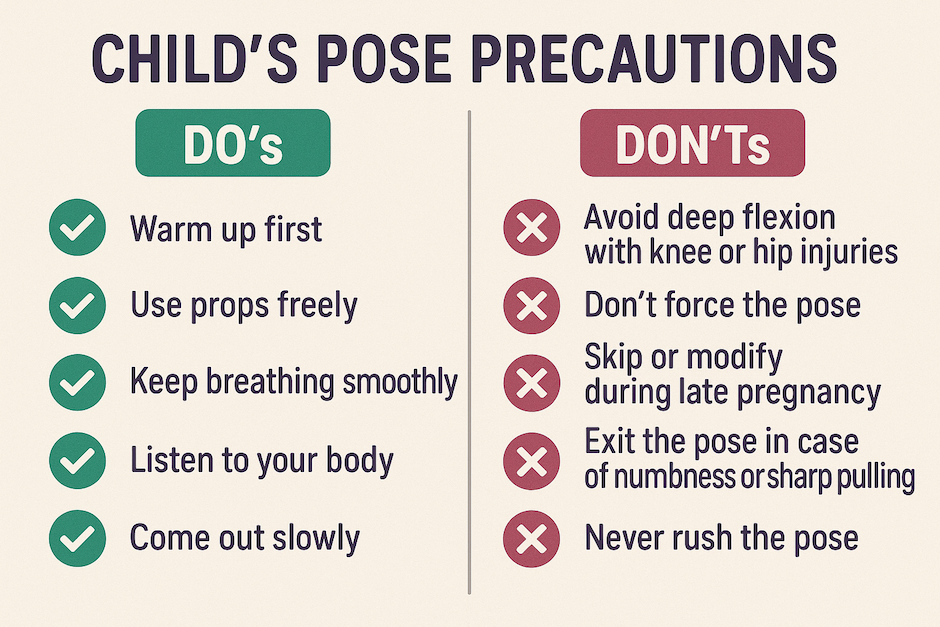
Do’s
- Warm up first: Ease into Child’s Pose after gentle stretching or movement.
- Use props freely: Bolsters, blankets, or cushions under your torso, knees, or ankles make the pose accessible.
- Keep breathing smoothly: If you can’t breathe comfortably, adjust your position or widen your knees.
- Listen to your body: Exit the pose if you feel sharp pain or tingling.
- Support your head and neck: Rest the forehead on a block, cushion, or folded arms if it doesn’t reach the mat.
- Come out slowly: Use your hands to lift up gently, avoiding sudden movement that can strain the back.
- Practice mindfully: Treat Balasana as an active relaxation, not a forced stretch.
Don’ts
- Avoid deep flexion with knee or hip injuries.
- Don’t force your hips to touch your heels — support them with props if needed.
- Skip or modify during late pregnancy unless guided by a prenatal yoga teacher.
- Avoid compressing the abdomen if you have back or digestive issues — try a wide-kneed, supported version instead.
- Don’t hold the pose if you feel numbness or sharp pulling in the knees, hips, or ankles.
- Avoid collapsing shoulders — allow gentle activity through the arms for spinal support.
- Never rush the pose — its benefits come from slow breathing and gradual release.
To practice with maximum safety, book a free 1-on-1 session today!
Child’s Pose (Balasana): Related Poses
If you enjoy Child’s Pose, here are a few similar poses that share its benefits while offering new challenges:
1. Cat-Cow Pose (Marjaryasana–Bitilasana)
Awakens spinal mobility and warms up the back muscles.
- Begin on your hands and knees in a tabletop position, wrists under shoulders, knees under hips.
- Inhale, drop your belly, lift your chest, and gaze forward (Cow Pose).
- Exhale, round your spine toward the ceiling, tucking your chin to your chest (Cat Pose).
- Continue moving with your breath for 5–8 rounds.
2. Puppy Pose (Uttana Shishosana)
Opens shoulders and lengthens the spine, preparing the body for a deeper Child’s Pose.
- Start on all fours with hips over knees.
- Walk your hands forward, lowering your chest toward the mat while keeping your hips stacked above your knees.
- Rest your forehead or chin on the mat and extend your arms fully.
- Breathe deeply, feeling a gentle stretch along the spine and shoulders.
3. Happy Baby Pose (Ananda Balasana)

Releases the lower spine and hips, complementing the grounding effect of Child’s Pose.
- Lie on your back and bend your knees toward your chest.
- Hold the outer edges of your feet with your hands, keeping your knees bent and thighs wide.
- Gently pull your feet down while keeping your tailbone grounded.
- Rock slightly side to side if desired, and breathe deeply.
4. Corpse Pose (Savasana)
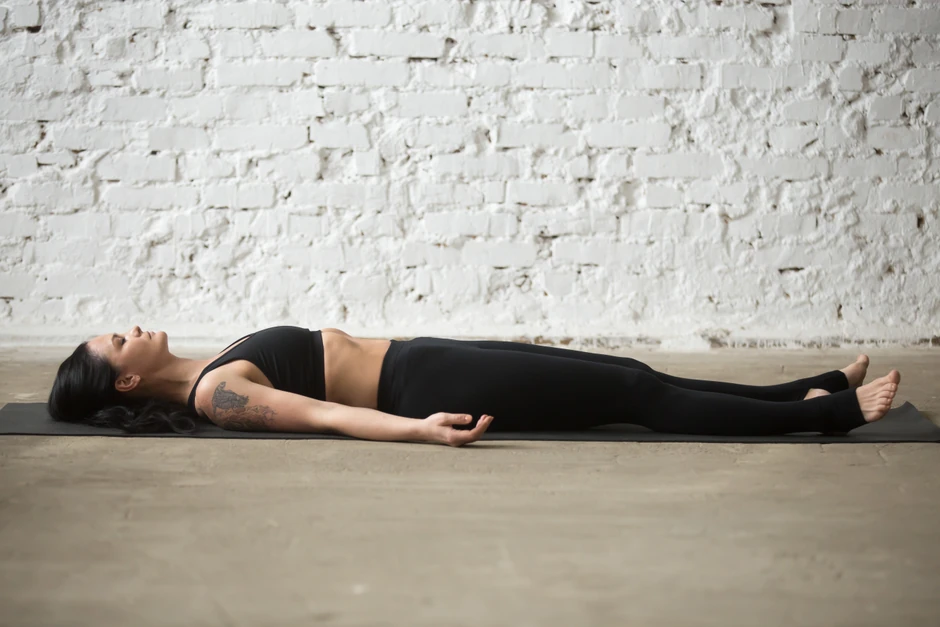
Integrates the benefits of practice through complete physical and mental surrender.
- Lie flat on your back with legs extended comfortably apart.
- Allow your arms to rest alongside the body, palms facing up.
- Close your eyes, soften your jaw and shoulders, and let your breath flow naturally.
- Stay here for 5–10 minutes, absorbing the calming effects of your practice.

Enjoy a Free 1-on-1 Session with a Coach!
Receive personalized guidance tailored to your unique fitness goals, live with a dedicated coach—no credit card required.
Frequently Asked Questions
Child’s Pose gently stretches the spine, hips, and thighs while calming the mind. It helps relieve back tension from long hours of sitting and promotes relaxation through steady, mindful breathing.
Absolutely. Child’s Pose is one of the most beginner‑friendly yoga postures. If your hips or knees feel tight, place a bolster or folded blanket between your thighs and calves for extra support.
You can stay in Child’s Pose for anywhere between 30 seconds to 5 minutes, depending on comfort. In restorative sessions, it can be held longer with props. The key is to keep breathing smoothly and stay relaxed.
Avoid deep forward folding if you have serious knee, hip, or ankle injuries, or if you’re in late pregnancy. Always modify under guidance—especially if you feel numbness, pain, or discomfort.
Yes, when done mindfully. It allows gentle decompression of the spine and eases tight lower‑back muscles. However, if you have acute pain or herniated discs, practice under a teacher’s supervision to ensure safe alignment.
Child’s Pose (Balasana) is a kneeling fold with hips resting on the heels, focusing on rest, grounding, and a gentle back stretch.
Puppy Pose (Uttana Shishosana) keeps the hips lifted above the knees while extending the arms forward, emphasizing shoulder opening and a deeper spine stretch.
In short: Child’s Pose is about relaxation and inward focus, while Puppy Pose targets shoulder flexibility and spinal lengthening.



.webp)
%20(7).jpg)




